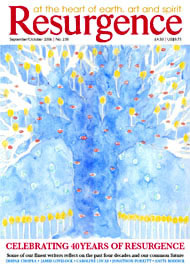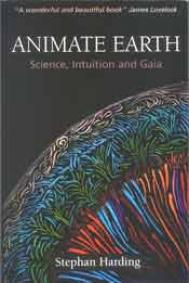OVER THE LAST thirty years I have read many books that have helped me to deepen my ecological consciousness and to strengthen my commitment to the care of this wonderful planet that is the source of the gift of my life. A few of these books stand out and they are ones that I have the occasion to teach with and also re-read from time to time. Let me name a few.
I think of The Dream of the Earth by Thomas Berry, Fritjof Capra’s Web of Life, David Abram’s Spell of the Sensuous, New and Selected Poems of Mary Oliver and Charlene Spretnak’s Resurgence of the Real. These are authors who leave you with the feeling that they truly love and care for the ground on which they walk. After reading Stephan Harding’s Animate Earth, I now add this book to my list.
This is an absolutely wonderful book which I would urge every reader of this review to make a part of their permanent library. Harding writes with a profound love, wonder, deep intuition and intelligence: conveying to the reader the utmost urgency of our present moment on the Earth, encouraging us to recover the ancient view of Gaia as a fully integrated, living being consisting of all her life forms, air, rocks, oceans, lakes and rivers, if we are ever to be able to halt the latest, and possibly the greatest, mass extinction. He also makes it clear, citing Stephan Jay Gould, that we have to “love what we want to save”. Animate Earth is the author’s work of love for Gaia.
Substantively, the task that Harding has set for himself is twofold. First, he takes his readers on an intellectual journey, helping them in the absolutely necessary transition from the mechanistic science of modern Western thought to a holistic science embedded in the very processes of the Earth and the universe. This is a paradigm book.
At the same time, Harding mentors his readers through meditative exercises into Gaian intuitions so that they can palpably feel what he is getting at when he talks about “animate Earth”. The subtitle of the book sets forth the dual task: Science, Intuition and Gaia.
In covering the scientific aspects, Harding introduces the concept of “animate Earth” through a deep order elaboration of James Lovelock’s Gaia hypothesis. In this work he is propounding an excursion into a post-modern animism that is based on the deep intuitions of indigenous peoples coupled with the findings of modern science. While at this task, the scope and range of his scholarship are breathtaking. He embeds Gaia, that is our “animate Earth”, in the wider universe processes akin to the work of Swimme and Berry’s Universe Story, then brings us into the minute details of the micro-cosmos that we see in the work of Margulis and Sagan’s Microcosmos. It is demanding work for the reader, but vitally necessary. It might be said that Harding ‘leaves no stone unturned’.
The hard scholarship is combined with wonderful meditative interludes throughout, to help the reader grasp what Harding is talking about at a deeply intuitive sensate bodily level. The reader is asked, at the beginning of the book, to find his or her own ‘Gaia Place’ to do these meditations. I consider them so valuable that I have committed myself to incorporating them into my ongoing personal practice.
Finally, the book reveals the personal character of the author. Harding loves the “gift of life” given him, and I certainly came to appreciate his gratitude as I read this book. A real treat on all levels!
Edmund O’Sullivan is Professor Emeritus and Associate Director of the Transformative Learning Centre at the Ontario Institute for Studies in Education.








